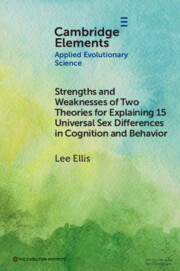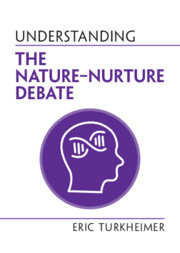Refine search
Actions for selected content:
222 results

Strengths and Weaknesses of Two Theories for Explaining 15 Universal Sex Differences in Cognition and Behavior
-
- Published online:
- 14 August 2025
- Print publication:
- 11 September 2025
-
- Element
-
- You have access
- HTML
- Export citation
14 - International Legitimacy as a System of Reference and Meaning
- from Part V - International Legitimacy and Change
-
- Book:
- The Law and Politics of International Legitimacy
- Published online:
- 14 July 2025
- Print publication:
- 24 July 2025, pp 259-282
-
- Chapter
- Export citation
Unequal neighborhoods, unequal skills: Adaptive functioning and access to community resources
-
- Journal:
- Journal of the International Neuropsychological Society , First View
- Published online by Cambridge University Press:
- 14 July 2025, pp. 1-6
-
- Article
-
- You have access
- Open access
- HTML
- Export citation
Partisan Change with Generational Turnover: Latino Party Identification from 1989 to 2023
-
- Journal:
- Journal of Race, Ethnicity and Politics , First View
- Published online by Cambridge University Press:
- 14 May 2025, pp. 1-25
-
- Article
-
- You have access
- Open access
- HTML
- Export citation
Are glucagon-like peptide-1 receptor agonists anti-consummatory drugs?
-
- Journal:
- CNS Spectrums / Volume 29 / Issue 6 / December 2024
- Published online by Cambridge University Press:
- 13 January 2025, pp. 536-541
-
- Article
-
- You have access
- Open access
- HTML
- Export citation
Understanding Sex-biases in Kinetoplastid Infections: Leishmaniasis and Trypanosomiasis
- Part of
-
- Journal:
- Expert Reviews in Molecular Medicine / Volume 27 / 2025
- Published online by Cambridge University Press:
- 09 January 2025, e7
-
- Article
-
- You have access
- Open access
- HTML
- Export citation
16 - Behavioral Observation and Coding
- from Part III - Deep Dives on Methods and Tools for Testing Your Question of Interest
-
-
- Book:
- Handbook of Research Methods in Social and Personality Psychology
- Published online:
- 12 December 2024
- Print publication:
- 19 December 2024, pp 378-403
-
- Chapter
- Export citation
8 - Intelligence
-
- Book:
- Understanding the Nature‒Nurture Debate
- Published online:
- 07 November 2024
- Print publication:
- 21 November 2024, pp 116-131
-
- Chapter
- Export citation
7 - GWAS Unchained, GWAS Unwound
-
- Book:
- Understanding the Nature‒Nurture Debate
- Published online:
- 07 November 2024
- Print publication:
- 21 November 2024, pp 100-115
-
- Chapter
- Export citation
2 - The Worst Legacy of Francis Galton
-
- Book:
- Understanding the Nature‒Nurture Debate
- Published online:
- 07 November 2024
- Print publication:
- 21 November 2024, pp 16-31
-
- Chapter
- Export citation
3 - Statistical Science and the Invention of Heritability
-
- Book:
- Understanding the Nature‒Nurture Debate
- Published online:
- 07 November 2024
- Print publication:
- 21 November 2024, pp 32-48
-
- Chapter
- Export citation
10 - Nature–Nurture and the Possibility of Human Science
-
- Book:
- Understanding the Nature‒Nurture Debate
- Published online:
- 07 November 2024
- Print publication:
- 21 November 2024, pp 148-166
-
- Chapter
- Export citation
6 - Plomin’s Predictions and the Human Genome Project
-
- Book:
- Understanding the Nature‒Nurture Debate
- Published online:
- 07 November 2024
- Print publication:
- 21 November 2024, pp 84-99
-
- Chapter
- Export citation
4 - Reports of Galton’s Death Are Greatly Exaggerated
-
- Book:
- Understanding the Nature‒Nurture Debate
- Published online:
- 07 November 2024
- Print publication:
- 21 November 2024, pp 49-66
-
- Chapter
- Export citation
9 - IQ, Race, and Genetics
-
- Book:
- Understanding the Nature‒Nurture Debate
- Published online:
- 07 November 2024
- Print publication:
- 21 November 2024, pp 132-147
-
- Chapter
- Export citation
5 - Thesis, Antithesis, Synthesis
-
- Book:
- Understanding the Nature‒Nurture Debate
- Published online:
- 07 November 2024
- Print publication:
- 21 November 2024, pp 67-83
-
- Chapter
- Export citation
1 - Genesis: Why Do We Care About Nature–Nurture?
-
- Book:
- Understanding the Nature‒Nurture Debate
- Published online:
- 07 November 2024
- Print publication:
- 21 November 2024, pp 1-15
-
- Chapter
-
- You have access
- HTML
- Export citation
Impact of an educational program on oncology nurses’ attitudes and behaviors toward care of the dying
-
- Journal:
- Palliative & Supportive Care / Volume 22 / Issue 6 / December 2024
- Published online by Cambridge University Press:
- 12 November 2024, pp. 1910-1918
-
- Article
- Export citation

Understanding the Nature‒Nurture Debate
-
- Published online:
- 07 November 2024
- Print publication:
- 21 November 2024
2 - Dynamical Systems
- from Part I - Lectures on Basics with Examples
-
- Book:
- Time-Variant and Quasi-separable Systems
- Published online:
- 24 October 2024
- Print publication:
- 31 October 2024, pp 21-40
-
- Chapter
- Export citation
